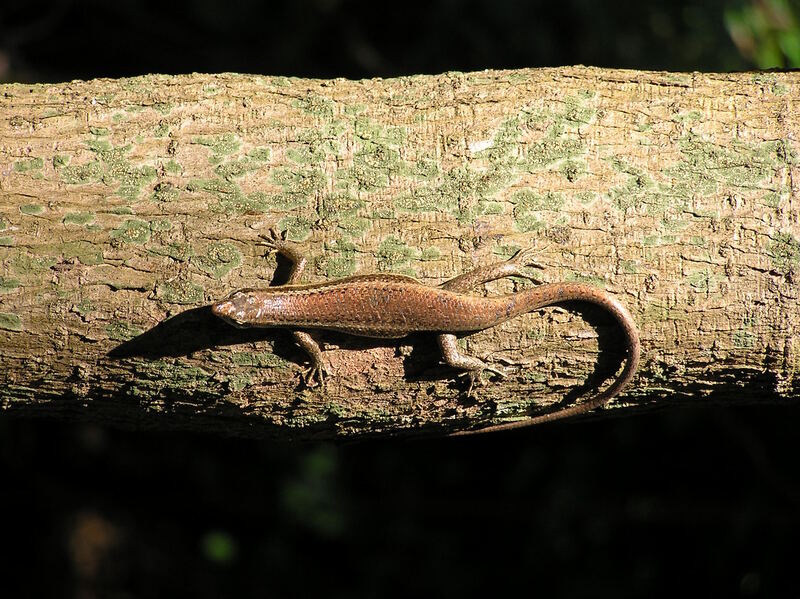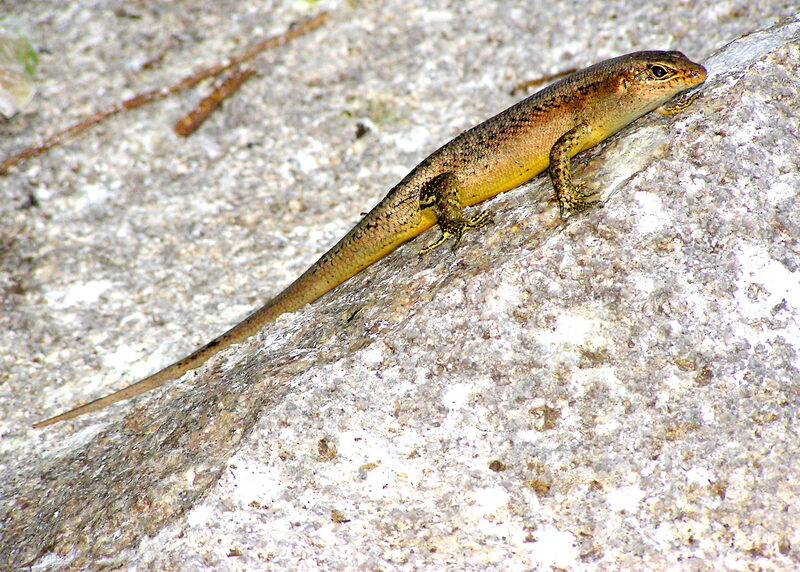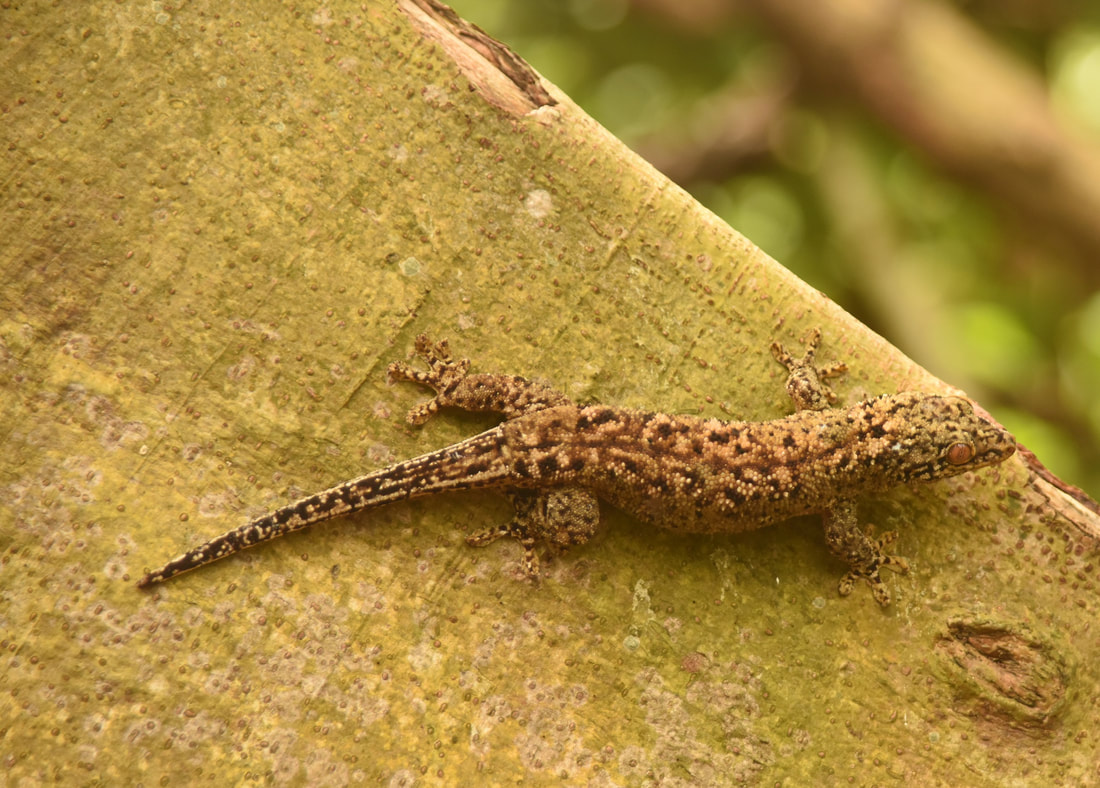Reptiles
Aride has one of the highest, if not the highest population density of lizards in the world, with seven species present on the plateau and hillside, six of them endemic. In addition, there are species of snake, terrapin and giant tortoise.
Detailed information about each species can be found via the button below the gallery.
Detailed information about each species can be found via the button below the gallery.
Lizards
Learn More
Bronze-eyed Gecko
Bronze-eyed Gecko Ailuronyx seychellensis, is so named because of the bronze-gold metallic coloration of their eyes, while the body is highly variable in colour. It is one of the largest gecko species in Seychelles, growing up to 20 cm in length. It is mainly nocturnal but can also be found during the daytime on tree trunks or sheltering in rock crevices. Insects, nectar, carrion and even seabird eggs are taken. The Bronze-eyed Gecko will rub against a branch to loosen dead skin then use its mouth to pull pieces off its body, revealing fresh new skin below. It will swallow the shed skin, probably to recycle nutrients such as protein and calcium or perhaps to avoid leaving evidence which may alert predators to their presence.
DID YOU KNOW?
Like many lizards, Bronze-eyed Gecko will drop its tail to escape predators. The predator is distracted by the tail, which for some time thrashes about and quivers like a tiny snake, giving the lizard time to escape. But the Bronze Gecko goes even further. When the body is held by a bird, for example, it twists to scurry away, leaving the aggressor holding on to tattered pieces of empty skin! In 1987 a team led by Aaron Bauer from the United States studied this phenomenon on Aride. They showed that the thinner and stronger inner layer of skin is separated from the thicker and weaker outer layer by loose connective tissue, and that there are weaknesses in the outer layer, enabling it to break and peel away easily.
DID YOU KNOW?
Like many lizards, Bronze-eyed Gecko will drop its tail to escape predators. The predator is distracted by the tail, which for some time thrashes about and quivers like a tiny snake, giving the lizard time to escape. But the Bronze Gecko goes even further. When the body is held by a bird, for example, it twists to scurry away, leaving the aggressor holding on to tattered pieces of empty skin! In 1987 a team led by Aaron Bauer from the United States studied this phenomenon on Aride. They showed that the thinner and stronger inner layer of skin is separated from the thicker and weaker outer layer by loose connective tissue, and that there are weaknesses in the outer layer, enabling it to break and peel away easily.
Gardiner's Burrowing Skink
Gardiner’s Burrowing Skink Pamelaescincus gardineri recalls British zoologist John Stanley Gardiner (1872-1946), who collected the first known specimens in 1905; the genus name Pamelaescincus was coined by American herpetologist Allen Greer, to honour Pamela, the older of his two sisters.
DID YOU KNOW?
Gardiner’s Burrowing Skink could be mistaken for a Seychelles Skink, but its behaviour is very different: instead of crawling in open ground or on rocks and tree-trunks, it lives in the leaf litter. It sometimes surfaces but, at the slightest disturbance, dives and seems to “swim” away through the leaves, wriggling its body rather than using its legs, which are reduced in size and function.
DID YOU KNOW?
Gardiner’s Burrowing Skink could be mistaken for a Seychelles Skink, but its behaviour is very different: instead of crawling in open ground or on rocks and tree-trunks, it lives in the leaf litter. It sometimes surfaces but, at the slightest disturbance, dives and seems to “swim” away through the leaves, wriggling its body rather than using its legs, which are reduced in size and function.
Green Day Gecko
Green Day Gecko Phelsuma astriata semicarnata is one of three races of this species endemic to Seychelles. The nominate race is present on the larger granitic islands and another race on Astove. It has an amazingly rich repertoire of interaction displays and responses including tail waving, tongue threats, back-arching, bloating, lateral presentation, head jerking, an exaggerated alert posture walk, lunging and chik-chik vocalisation. Only males performed jerky walking and only females perform exaggerated leg lifting and head quivering.
DID YOU KNOW?
The Green Day Gecko is bright green in daylight but at night or in shade, becomes blackish-green. If a light is shone on a gecko at night, it changes colour within 3 minutes, the tail transforming more slowly than the rest of the body, which appears mottled during the transition process.
DID YOU KNOW?
The Green Day Gecko is bright green in daylight but at night or in shade, becomes blackish-green. If a light is shone on a gecko at night, it changes colour within 3 minutes, the tail transforming more slowly than the rest of the body, which appears mottled during the transition process.
Seychelles Skink
Seychelles Skink Trachylepis sechellensis is a medium-sized slender skink, with striped sides, found throughout the island. Skinks are similar in appearance to other lizards but lack necks and they have very short legs; their long tails that are easily shed. Their smooth, shiny scales make them appear wet
DID YOU KNOW?
Although its smooth, shiny scales make it appear wet, Seychelles Skink occupies a relatively small geographic range, it is common throughout the granitic islands even on islands where there are rats (unlike Wright’s Skink) and other predators such as Common Myna. Hence its conservation status has been assessed by IUCN as Least Concern.
DID YOU KNOW?
Although its smooth, shiny scales make it appear wet, Seychelles Skink occupies a relatively small geographic range, it is common throughout the granitic islands even on islands where there are rats (unlike Wright’s Skink) and other predators such as Common Myna. Hence its conservation status has been assessed by IUCN as Least Concern.
Wright's Skink
Wright’s Skink Trachylepis wrightii is only found on rat-free seabird islands such as Aride where they benefit from the large numbers of seabirds, feeding on discarded fish and squid, fallen or unattended eggs, dead birds and even the droppings of nestlings. The absence of predatory rats is important as well as food resources. Wright’s Skink, like Aride’s unique shrub Wright’s Gardenia, is named after Edward Perceval Wright from Ireland, who visited Seychelles for 6 months in 1867 and was the first naturalist to collect specimens.
DID YOU KNOW?
Most skinks are small and this is one of the largest species in the world. Most species are striped or otherwise patterned, but Wright’s Skink is a more uniform metallic brown in colour, with barely discernible longitudinal stripes.
DID YOU KNOW?
Most skinks are small and this is one of the largest species in the world. Most species are striped or otherwise patterned, but Wright’s Skink is a more uniform metallic brown in colour, with barely discernible longitudinal stripes.
Other reptiles (Chelonia and snake)
Learn More
Aldabra Giant Tortoise
Aldabra Giant Tortoise Aldabrachelys gigantea is the only surviving species of family once found throughout the western Indian Ocean islands. Most of the Indian Ocean species were wiped out by 1840 following the arrival of European settlers. . Aldabra Giant tortoises were reintroduced to Aride to aid the recovery of Seychelles Magpie-robin. The birds will follow tortoises to feed on invertebrates disturbed in the leaf litter.
DID YOU KNOW?
The sound of the male mating Aldabra Giant Tortoise is the loudest noise in the reptile kingdom. Aldabra Giant Tortoises mate from February to May, laying 9-25 golf-ball sized eggs during June to September. Eggs hatch after about 120 days. Maturity is reached at 20-25 years. The snout of the Aldabra Giant Tortoise is adapted to allow it to drink through its nose.
DID YOU KNOW?
The sound of the male mating Aldabra Giant Tortoise is the loudest noise in the reptile kingdom. Aldabra Giant Tortoises mate from February to May, laying 9-25 golf-ball sized eggs during June to September. Eggs hatch after about 120 days. Maturity is reached at 20-25 years. The snout of the Aldabra Giant Tortoise is adapted to allow it to drink through its nose.
Black Mud Terrapin
Black Mud Terrapin Pelusios subniger is a widespread mainland Africa freshwater marsh species that also occurs in Seychelles and Madagascar. Terrapins occurred at Aride historically, but disappeared, probably due to deterioration and the progressive filling of the Aride marsh. In 2010, ICS rehabilitated the marsh and in 2012, 15 terrapins from the healthy population at Frégate Island were transferred to Aride. The taxonomic status of the species in Seychelles is unclear. Some consider it to be a Critically Endangered subspecies parietalis, endemic to Seychelles but others believe it was introduced from Africa by humans. While debate continues, ICS has taken a precautionary approach in favour of the species.
DID YOU KNOW?
Terrapins of the genus Pelusios, also known as Side-neck Turtles. They have a hinge at the front of the shell allowing them to pull up the plastron after withdrawing the head and feet. The Creole name is Torti Soupap referring to this habit (soupap means a plug or valve).
DID YOU KNOW?
Terrapins of the genus Pelusios, also known as Side-neck Turtles. They have a hinge at the front of the shell allowing them to pull up the plastron after withdrawing the head and feet. The Creole name is Torti Soupap referring to this habit (soupap means a plug or valve).
Seychelles Wolf Snake
Seychelles Wolf Snake Lycognathophis seychellensis is a non-venomous snake of up to 1 metre in length, one of two snake species endemic to Seychelles. There are two distinct colours: yellow phase or dark phase. Yellow individuals have a yellowish-brown back, decorated with faint dark spots and a bright yellow underside. Dark phase snakes a grey or blackish with dark spots on the back and a white underside covered with small dark spots. It has a small head and conspicuous, fairly large, coppery-gold eyes. It is listed as Endangered by IUCN.
DID YOU KNOW?
Seychelles Wolf Snake is the only member of the genus Lycognathophis, the name derived from the Greek words lykos meaning "wolf", gnathos meaning "jaw" and ophis meaning "snake", referring to the snake's dentition.
DID YOU KNOW?
Seychelles Wolf Snake is the only member of the genus Lycognathophis, the name derived from the Greek words lykos meaning "wolf", gnathos meaning "jaw" and ophis meaning "snake", referring to the snake's dentition.















